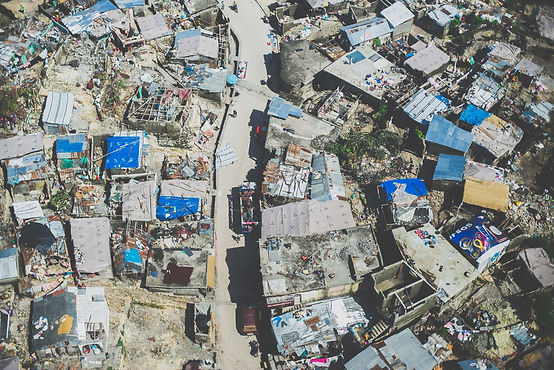
WHAT WE DO
& THE PROBLEMS WE FACE
OUR GOAL
Recycle Rebuild aims to create jobs, help the environment, empower communities and resolve supply/demand issues for specific building materials and products. We do this by identifying products that are in high demand, then employing and training members of the community to help them make up to 100% recycled waste products. These materials can then be sold at an affordable price and the profits reinvested into the newly-formed micro-enterprise, creating a self-sustaining business that can grow to meet the wider demands of the region for the long term.

THE PROBLEM
Wherever or whenever they strike, natural disasters have several things in common: they cause widespread unemployment, generate vast quantities of waste and inflate the prices of building materials (for both local people and humanitarian agencies) due to sudden, increased demand for particular items.
Relief efforts bring in a large volume of supplies to address these key life-threatening issues. The plastic bottles used to supply much-needed water are either burned, (causing air pollution amongst other hazards) or are discarded creating the perfect breeding environment for mosquitos that have the potential to cause an epidemic that leads to further deaths.
NGOs focused on response work relating to temporary structures or recovery of major permanent structures are required to purchase materials. This either requires the NGO to import materials from another district or country, or purchase locally but potentially add to the inflation of prices due to demand. This results in two problems; firstly, purchasing and importing materials from afar means that the NGOs are not fully investing in the community. Secondly, if the materials are purchased locally (although perhaps not fabricated locally) the NGO is forced to waste money on an inflated price.
WHAT WE DO
Recycle Rebuild creates jobs, helps the environment, empowers communities and resolves supply/demand issues for specific building materials after natural disasters. We do this by identifying building materials that are in high demand and employing and training the affected communities to make them using up to 100% recycled waste products. These materials can then be sold at an affordable price and the profits reinvested into the newly-formed micro-enterprise, creating a self-sustaining business that can grow to meet the wider demands of the region for the long term.


WE EMPOWER
Recycle Rebuild aims to create sustainable opportunities for the community, both in regards to a long-term source of income and in providing the community with a model to fund the continued cleanup of their community. This results in communities that are no longer dependent on any outside source of materials or employment.
Manufactured materials are fabricated based on local demand, creating a practical resource for the community to construct whatever they need without having to significantly modify the tools they currently have available.
Waste is defined as an eliminated or discarded material, which is no longer useful or required after the completion of a process. This means that it is usually free or can be obtained for little cost. As a raw material, it is extremely useful and easily made into a low-priced, locally sourced product. During the post-disaster period, product prices usually become more expensive due to increased demand, scarcity and supplier monopoly, especially with the need for importation. This can lead to inflated material costs in an environment where many communities struggled to afford the cost of pre-disaster materials. Recycle Rebuild aims to provide low cost materials whose production directly benefits the local community.
WE EMPLOY
Natural disasters are devastating to the lives of those affected by them. Many lose their jobs either due to the collapse of the structure, the disappearance of tourism or due to a larger economic problem in the area.
Recycle Rebuild provides an opportunity for those affected, on day one, to learn new skills and be employed in a sustainable and long term opportunities. The model implemented by Recycle Rebuild offers opportunities at all skill levels, and work hours. Tasks can be as simple as collecting waste off the streets to the construction, repair and maintains of the machines used to recycle. Helping both clean up the environment and the disaster zone.
Through the creation of new waste streams within the community Recycle Rebuild develops a social business run by the community, for the community, and by sharing the concept, our startup expertise and guidance we can hand this over for the long term benefit of the community.


WE RECYCLE
Recycled plastic can be used to make things such as school desks, playgrounds, tools and even boats, yet 91% of plastic is never recycled. Post-disaster, plastic waste collection/recycling facilities, if they even existed before, are likely to be disrupted. Plastic then builds up in waterways, reaching our oceans and adding to the 5.25 trillion pieces already there. Some communities turn to burning plastic in an effort to deal with the waste buildup, releasing various harmful chemicals, most notably dioxin, which causes respiratory problems. Sometimes communities are left with no choice but just to let it build up, creating a breeding ground for disease or harming local wildlife who mistake it for food.
Recycle Rebuild addresses these issues and helps to protect our planet by following the United Nations Sustainable Development Goals. We aim to protect Life Below Water (Goal 14) & Life on Land (Goal 15) by cleaning up these materials from our environment, preventing them from entering the water source, or entrapping/eaten by animals. Through Responsible Consumption and Production (Goal 12), we aim to reduce the need to consume new valuable resources such as wood and plastics, thereby reducing the carbon footprint caused by the creation and transportation of these materials, helping fight Climate Action (Goal 13).
